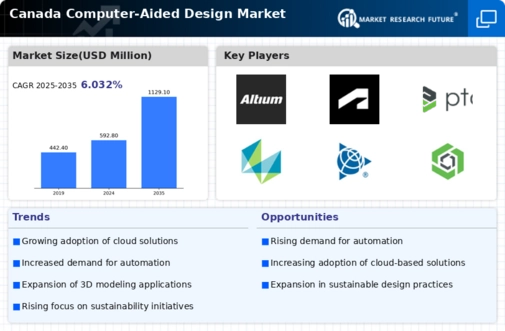Growing Demand for Customization
Customization is becoming a pivotal driver in the computer aided-design market in Canada. As consumer preferences shift towards personalized products, industries such as automotive and consumer electronics are increasingly relying on CAD tools to meet these demands. The ability to tailor designs to specific customer requirements not only enhances user satisfaction but also fosters brand loyalty. In 2025, it is estimated that the demand for customized design solutions will contribute to a 15% increase in CAD software usage among Canadian manufacturers. This trend underscores the importance of flexibility and adaptability in design processes, compelling companies to invest in advanced CAD technologies that facilitate customization.
Focus on Collaborative Design Solutions
Collaboration is becoming increasingly vital in the computer aided-design market in Canada. As projects grow in complexity, the need for effective teamwork among designers, engineers, and clients is paramount. Collaborative design solutions, which enable real-time sharing and editing of CAD files, are gaining traction. In 2025, it is projected that the market for collaborative CAD tools will expand by 12%, reflecting the growing emphasis on teamwork in design processes. This trend is particularly relevant in industries such as architecture and product design, where multidisciplinary teams must work together seamlessly. The computer aided-design market is thus evolving to support enhanced collaboration, ultimately leading to more innovative and successful design outcomes.
Technological Advancements in CAD Software
the market is experiencing a surge due to rapid technological advancements in CAD software.. Innovations such as parametric modeling, 3D visualization, and real-time rendering are enhancing design capabilities. These advancements allow designers to create more complex and detailed models, which can lead to improved product quality and reduced time-to-market. In 2025, the CAD software segment is projected to grow by approximately 10% in Canada, driven by the increasing demand for sophisticated design tools across various industries, including architecture, engineering, and manufacturing. As companies seek to improve efficiency and reduce costs, the adoption of advanced CAD solutions is likely to become a critical factor in maintaining competitive advantage within the computer aided-design market.
Rising Adoption of Virtual Reality in Design
The integration of virtual reality (VR) technology into the design process is emerging as a transformative driver in the computer aided-design market in Canada. VR allows designers and clients to immerse themselves in 3D environments, facilitating better visualization and understanding of design concepts. This technology enhances collaboration and communication among stakeholders, leading to more informed decision-making. As of 2025, the adoption of VR in CAD applications is anticipated to grow by 20%, as companies recognize its potential to streamline workflows and improve client engagement. The computer aided-design market is likely to see a shift towards more interactive and immersive design experiences, driven by this technological evolution.
Increased Investment in Infrastructure Development
the market is poised for growth due to increased investment in infrastructure development.. Government initiatives aimed at enhancing transportation networks, public facilities, and urban development projects are driving demand for CAD solutions. In 2025, infrastructure spending in Canada is projected to reach $200 billion, creating a substantial market for CAD applications in civil engineering and architecture. This influx of capital is likely to stimulate innovation and adoption of advanced design tools, as stakeholders seek to optimize project outcomes and ensure compliance with regulatory standards. Consequently, the computer aided-design market is expected to benefit significantly from these investments.

















Leave a Comment